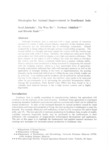Strategies for Animal Improvement in Southeast Asia
Tropical agriculture research series : proceedings of a symposium on tropical agriculture researches
| ISSN | 03889386 |
|---|---|
| NII recode ID (NCID) | AA00870529 |

Full text
tars25-_67-76.pdf1.66 MB
Although Southeast Asia is endowed with a large amount of resources necessary to create a viable animal industry especially in the ruminant sector, the resources are not well-utilized due to technology constraints. Animal productivity is being enhanced through various crossbreeding programs. The swamp buffalo is a draught and meat animal but crosses with the riverine type can increase milk yield 2 1/2, times. Similarly, the indigenous cattle grow slowly and produce very little milk but display a very high reproductive efficiency. The dairy industry in the region is still in infancy but steps are taken to introduce Bos indicus and Bos laurus crossbreds which have a greater milking ability. Mutton and goat meat production is being increased by integrating the animals with the cropping systems - which is a very sustainable form of agriculture. Grazing experiments indicated that with well-managed pastures as well as the application of strategic feeding in the form of supplementation, the grazing intensity can be raised and yield of up to l,l00kg/ha per year of body weight can be achieved. Crop residues and by-products can be utilized for animal production but in the majority of the cases, the nutritive value needs to be improved either by pre-treatments or by increasing the microbial fermentation ability. Among the by-products, Palm Kernel Cake (PKC) has been found to be a valuable feed material because it has a high protein content and is highly degradable.
| Date of issued | |
|---|---|
| Creator | Syed Jalaludin Yin Wan Ho Norhani Abdullah Hiroshi Kudo |
| Publisher | Japan International Research Center for Agricultural Sciences |
| Volume | 25 |
| spage | 67 |
| epage | 76 |
| Language | eng |
